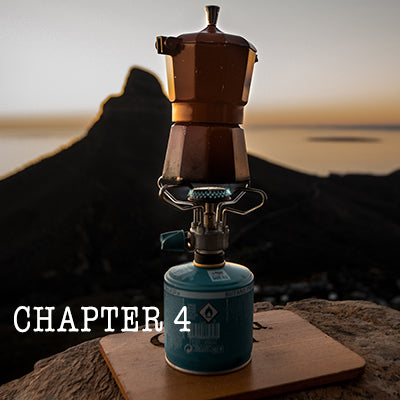Chapter 4 of COVID-19 Coffee Survival Guide
Fresh Matters
If you have been keeping up with our series on the Covid-19 Survival Guide to Coffee, you would have:
- Bought some fresh coffee that has a freshness expectancy of 3 to 14 days old from the roast date.
- Actively sought out coffees that displayed their birth date, and ignored coffees with expiry dates, or "death dates" or no dates at all.
- Managed to grind this "Fresh" coffee on either a Burr Grinder (first choice), or managed to do a better job of using your Whirly Blade Grinder.
Ok..so you made a few pots of coffee and hopefully noticed a big difference after following the first few steps of this guide.
Now what?
Now we can start to look at the other coffee contraptions we accumulated over the years, and put them to proper use.
Moka Pot, or Stove Top Espresso
If you have Italian friends, and they offer you a "caffe" , chances are they pull out a stove top device that unscrews in four parts, (base, top pouring chamber or pitcher, basket and basket cover) called a Moka Pot.
This device is almost always incorrectly referred to as a "Stove Top Espresso Maker". Although the Moka Pot is a pressure brewed device that makes a tiny coffee that packs a nice, concentrated punch, it cannot be called an espresso.
It's a Moka, or technically, a stove top coffee, but never espresso. The pressure generated is too low and the temperature of the water is heated too high to be called an espresso. But it is a legitimate drink, and in a pinch, is a good ALTERNATIVE to espresso.
Note that I said ALTERNATIVE, not SUBSTITUTE. Much like a poached egg to soft stage, is a good ALTERNATIVE to an OVEREASY EGG, with a runny yolk.
It's been a while since I have made a Moka Pot to be honest, so this guide offers me a good chance to be reacquainted with an old friend, except that I've moved up in the world since, as I now own an "induction-friendly" Moka Pot which lets me have the control over temperature a little more precisely than the last time I made a Moka Pot on a simple electrical range.
That being said, having more temperature control means very little when it comes to the Moka Pot because we have to get the water to boil anyways. But it makes me feel more special (coffeesnob!)
How to Use a Moka Pot
- Grind some coffee.Now in our previous series about the drip coffee maker, we learned how to grind with our simple blade grinder by pre-measuring coffee and grinding using a counting method, while shaking the grinder. We will do the same in this case, except that we will grind about 10 seconds longer than we did for our drip coffee maker.
- Use a scale and measure out the appropriate amount of coffee. This amount will vary on the size of the moka pot you are using, so some experimenting will be involved. Basically, you need to put enough ground coffee in the removable funnel-shaped metal basket inside the moka pot, to approximately a depth of a 1/2".
- Look for a puck of coffee that will offer some resistance to the boiling water that will percolate through the puck. Again, the count is not a predictable thing and will require some trial and error. Be sure not to grind it so much that it displays the fineness of grind that we typically find in real espresso, and turkish coffee, but finer than our drip coffee.
- Pack in the coffee lightly, you don't really need to tamp the coffee puck, just level it with the top screen. Boil some water in a kettle, this will speed things up and keep the parts cooler than boiling everything on top of the stove.
- When the water comes to a boil, pour water in the empty bottom ( with the funnel basket and top filter removed) of the Moka Pot to the appropriate level. Some of you may want to measure this amount carefully with a measuring cup or scale, but most of these Moka Pots have lines on the inside telling you where to fill, so just use those. Quickly insert the funnel basket and it's filter top into the base, and immediately screw on the top firmly. Now place the whole unit (remembering to use the insulated handle because the base is hot from the water!), on your heating element and turn it to medium. Your hot water should return to a boil very quickly, causing the water to rise up and percolate through your coffee puck, until it deposits a thick, deep coloured, liquid into the upper pouring chamber. Keep the lid of the pouring chamber open so you can see all this happening and when it starts to sputter that means all your water is gone, so turn off your heat source, and enjoy! .
That's it.. pretty simple. Feel free to experiment, these are not set recipes in stone because we all have different beans, different moka pots, different water, different grinders, you get the idea. Use finer grind, more ground coffee, less ground coffee, etc. I am freeing you to experiment, just remember to write down what you did so you can REPLICATE it.
Remember to let everything cool down before you unscrew the Moka Pot to dump out the spent grounds and wash all the parts. Make sure you clean it after every use. The idea of leaving it dirty to " season" is just a myth, unless you love the taste of burnt, rancid coffee oils. The only time seasoning metal brewing devices is legitimate is when it is done to remove traces of manufacturing oils and compounds. Other than that, clean it..because it's gross!
----------------------------
MORE ON THE COVID SURVIVAL COFFEE GUIDE
CHAPTERS:
Chapter 1: If you’re ready to make a change and freshen up your coffee game, consider making your coffee at home. To produce quality coffee at home, like the ones you normally find in the coffee shops, follow these 3 simple rules... Read More >
Chapter 2: Now that you understand freshness as it pertains to coffee beans (3-14 days from its BIRTH DATE or Roast date, and only buy enough to last a week) . This will give us a good starting point because we finally have some quality ingredients...Learn More >
Chapter 3: Ok.. you managed to escape the matrix and now that you have acquired the supplies needed to take on the coffee universe on your own, we are here to offer you some help!
4 Tools Needed to Brew Coffee At Home... Read More >
Chapter 4: If you have Italian friends, and they offer you a "caffe" , chances are they pull out a stove top device that unscrews in four parts, (base, top pouring chamber or pitcher, basket and basket cover) called a Moka Pot...Learn More >
Chapter 5: I have a personal problem with pour over people because they tend to hold the opinion that pour overs like Hario v60, Chemex, Kalita, are great, but that batch brew Drip Coffee Makers suck. The reality is...Read More >
Chapter 6: Let's explore further why the proponents of Cold Brew coffee are so maniacal in their support of this process. 4 reasons: ... Learn More >
Chapter 7: Frankly this viral hype surprises most of us in the industry but, in my opinion, it is a good thing that people are seeking innovation when it comes to coffee beverages. I just wish it didn’t involve instant coffee! ... Learn More >
Chapter 8: Prior to the cold brew fad, the go-to method of making a cold coffee was to utilize the alien👽 technology known as ice.
Apparently, when you add ice to things, they get colder...Learn More >
Chapter 9: If you survive this chapter, you will have my respect, and moreover, you will have learned about the basic principles of extraction...Learn More >
Chapter 10:We are revisiting a brewing device that was long ago dismissed as an alternative for espresso. Of course I'm talking about the Aeropress. Full admission. I was an anti Aeropress-er (not anymore). For those of you not familiar with the Aeropress way of making coffee it's a strange looking plastic device that looks like a giant syringe...Learn More >
Chapter 11: I'm going to tread into dangerous waters here and talk about one of the most controversial taboo subjects in the realm of 3rd and 4th wave coffee (aka pretentious coffee). What am I talking about? Blended drinks.. , AKA frappuccinos...Learn More >
Chapter 12:There is a false belief marketed that you need to spend a lot of money on specialized equipment in order to make good coffee and latte art. This insidious belief implies you need to...Learn More >
Chapter 13:The easiest way to avoid cream and sugar in your coffee is to buy higher quality coffee, you will taste that it is naturally sweet as opposed to the dark burnt, bitter stuff from chain stores, so try out a local independent coffee shop...Learn More >
Post Pandemic:Luckily, in the past the coffee industry has proven itself relatively recession-proof. Big question is, if it is pandemic proof ?...Learn More >



